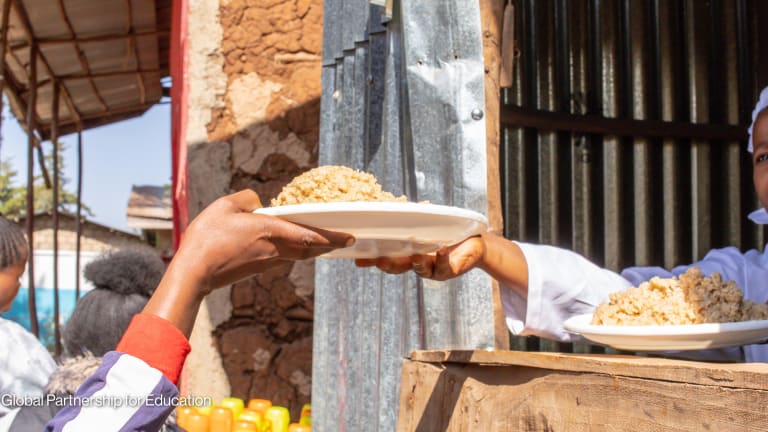
Swanpan Kumar Biswas, a fish farmer from Bangladesh, used to travel 23 kilometers to purchase expensive feed to ensure his fish grew large, and quickly. He and his neighbors needed a new solution that would allow them to access good quality feed closer to home and at a lower cost.
Getting access to a simple innovation — a semi-automatic feed mill that that allows the farmers to produce their own good quality feed for a better price — has helped Swanpan and his colleagues to boost their production and profits. His fish now grow in 10 days as much as they used to in 15 days.
This is just one story, in one country, where science and innovation are helping to move farmers from poverty, to prosperity. But all over the globe, these solutions are helping the world’s 570 million farmers to transform their lives. In a world where 793 million people in the world are still undernourished, and it is estimated that 100 million people could be pushed back into poverty due to climate change — we need to be making efficient investments in innovative scientific solutions.
To demonstrate exactly what is working and where, Farming First and CGIAR Consortium have teamed up to produce a collection of case studies, titled “Celebrating Science and Innovation in Agriculture.”
The stories are divided into five categories to show where donors and development practitioners can make the biggest impact:
1. Science to help manage natural resources.
For example, in Indonesia, satellite mapping systems by Farming First supporter Digital Globe are helping the World Resources Institute track land change in forest areas. Nirarta Samadhi of WRI Indonesia, speaks of how he can no longer take his son to fish in the zones he fished in as a boy, as fires are damaging the environment.
“Digital Globe provides a clear image of what is happening on the ground. With that type of high resolution image we can analyze it, and develop a better policy,” he said.
2. Spreading scientific knowledge.
In Africa, rice production is not keeping up with demand. Changing diets and rapid population growth mean that cultivation of this staple crop must dramatically increase its efficiency.
To close the yield gap, CGIAR Center AfricaRice, has developed an app for providing African farmers with field-specific management guidelines called “RiceAdvice.” It is an interactive tool that generates recommendations based on farmers’ answers to around 20 questions. RiceAdvice can identify the best choice of fertilizers to be purchased based on nutrient requirement and fertilizer prices, and their amounts and application timing. It has been tested in the Senegal River valley and Kano, Nigeria, and farmers can also select their own target yield level based on their budget. Results show that RiceAdvice guidelines give more than 1 ton per hectare of yield advantage compared with farmers’ practices.
3. Science to improve farmers’ tools.
Swanpan’s story demonstrates the difference that having access to innovative tools can make to a farmer’s livelihood. In Ethiopia, access to varieties of lentils, chickpeas and faba beans that have a higher resistance to diseases is preventing farmers losing their crop when rust disease strikes, as it did in 2005, devastating farmers’ fields. And in Asia, more than 5 million farmers are growing “scuba rice” that can survive under flooding for three weeks.
4. Science to build resilience to shocks and stresses.
In Ethiopia, 8.2 million people are in need of humanitarian assistance due to the current drought, coupled with successive failed seasons. However, districts where Farming First supporter World Vision has implemented Farmer Managed Natural Regeneration are exhibiting greater resilience. FMNR means helping naturally occurring trees to return to the landscape to help to keep the soil from washing away, to shade crops and to help the land to hold water.
Compared to the adjacent districts, agricultural production of the households that applied FMNR have largely been unaffected due to high moisture retention in their soils. Rivers and hand-dug wells have sufficient water despite reduced precipitation. Income from agricultural production has increased by more than double. Fodder for livestock, wood supply, and a stable microclimate all remain intact.
5. Science to improve market access.
In Kenya, existing financial institutions have only met 1 percent of the overall demand for credit in agriculture. Umati Capital, a financial services company, is harnessing data and technology, to help small- and medium-sized enterprises digitize their business, in order to unlock cash for immediate growth.
For example, the startup helped the the leading fair trade and organic certified Kenyan exporters of macadamia and cashew nuts by providing invoice discounting, and automating the exporter’s supply chain processes, enabling on-time payments for the farmers. As a result, the exporter increased purchases from farmers by 50 percent and improved efficiencies in procurement by 9 percent.
These stories show just what science and innovation can achieve — and what a smart investment it can be. Investing in science and innovation for agriculture can go beyond simply meeting food security needs, but contribute to broader interlinked goals such as natural resource management, improved nutrition and resilient rural livelihoods. As we begin our path towards the Sustainable Development Goals, it is these solutions we should embrace.
Join the Devex community and access more in-depth analysis, breaking news and business advice — and a host of other services — on international development, humanitarian aid and global health.








